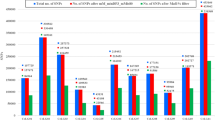Abstract
In the studied conditions of cellulose acetate electrophoresis only glucose-6-phosphate isomerase (PGI, EC 5.3.1.9) appeared to be a polymorphic isozyme. The PGI analysis of 23 cabbage (Brassica oleracea var. capitata) inbred lines, carried out in two years, allowed detecting off-type individuals in four lines. Seed contamination caused by sib-pollination was detected in 10 out of 19 F1 hybrids. In five of them the contamination did not exceed 5 %, and in the remaining five, ranged from 27–52 %. Also homozygosity of 67 plants obtained through anther culture in vitro was confirmed. The results indicate that PGI electrophoresis in cellulose acetate matrix is very fast and can be useful in the assessment of genetic purity in cabbage breeding materials.
Similar content being viewed by others
References
Arus P., 1983. Genetic purity of commercial seed lots. In: Isozymes in Plant Genetics and Breeding, Part A. Tanksley S.D., Orton T.J. (eds). Elsevier Sci. Pub., Amsterdam, pp. 415–423.
Arus P., Shield C.R., Orton T.J., 1985. Application of isozyme electrophoresis for purity testing and cultivar identification of F1 hybrids of Brassica oleracea. Euphytica 34: 651–657.
Arus P., Tanksley S.D., Orton T.J., Jones R.A., 1982. Electrophoretic variation as a tool for determining seed purity and for breeding hybrid varieties of Brassica oleracea. Euphytica 31: 417–428.
Bolkan H.A., Williamson V.M., Waters C.M., 1987. Use of cellulose acetate electrophoresis as an alternative to starch gel electrophoresis for detecting root-knot nematode resistance in tomato. Plant Disease 71: 1001–1003.
Campion B., Bohanec B., Javornik B., 1995. Gynogenic lines of onion (Allium cepa L.): evidence of their homozygosity. Theor. Appl. Genet. 91: 598–602.
Chevre A.M., Delourme R., Eber F., Margale E., Quiros C.F., Arus P., 1985. Genetic analysis and nomenclature for seven isozyme systems in Brassica nigra, B. oleracea and B. campestris. Plant Breed. 114: 473–480.
Gotoh S., Ikehashi H., 1992. Survey of isozyme genes by polyacrylamide gel electrophoresis in couliflower, broccoli and cabbage. Japan. J. Breed. 42: 23–32.
Hebert P.D.N., Beaton M.J., 1989. Methodologies for allozyme analysis using cellulose acetate electrophoresis. Univ. of Windsor, Windsor, Ontario.
May B., 1991. Starch gel electrophoresis of allozymes. In: Hoelzel A.R. (ed) Molecular genetic analysis of populations. Oxford University Press, Oxford, pp: 1–27.
McGrath J.M., Quiros C.F., 1992. Genetic diversity at isozyme and RFLP loci in Brassica campestris as related to crop type and geographical origin. Theor. Appl. Genet. 83: 783–790.
Nijenhuis B., 1971. Estimation of the proportion of inbred seed in Brussels sprouts hybrid seed by acid phosphate isoenzyme analysis. Euphytica 20: 498–507.
Orton T.J., Browers M.A., 1985. Segregation of genetic markers among plants regenerated from cultured anthers of broccoli (B.oleracea var. italica). Theor. Appl. Genet. 69: 637–643.
Palmer C.E., Keller W.A., Arnison P.G., 1996. Experimental haploidy in Brassica species. In: Jain S.M., Sopory S.K. and Veilleux R.E. (eds.) In vitro haploid production in higher plants. Vol. 3. Kluwer Acad. Pub., London pp: 173–192.
Richardson B.J., 1986. Allozyme Electrophoresis. A handbook for animal systematic and population studies. Academic Press, Sydney.
Samaniego F.J., Arus P., 1983. On estimating the sib proportion in seed-purity determination. Biometrics 39: 563–572.
Simonsen V., Heneen W.K., 1995. Genetic variation within and among different cultivars and landraces of Brassica campestris and B. oleracea based on isozymes. Theor. Appl. Genet. 91: 346–352.
Vallejos E. 1983. Enzyme activity staining. In: Tanksley S.D. and Orton T.J. (eds.) Isozymes in Plant Genetics and Breeding. Part A. Elsevier Sci. Pub.. Amsterdam.
Weeden N.F., 1989. Application of isozymes in plant breeding. In: Plant Breeding Reviews. Timber Press, Portland, Oregon, pp. 11–47.
Wills A.B., Wiseman E.M., 1980. Acid phosphatase isoenzymes of Brassica oleracea seedlings and their application to sib testing in F1 hybrids. Ann. Appl. Biol. 94: 137–142.
Author information
Authors and Affiliations
Rights and permissions
About this article
Cite this article
Barański, R. Application of a rapid glucose-6-phosphate isomerase assay in white cabbage breeding. Acta Physiol Plant 22, 45–51 (2000). https://doi.org/10.1007/s11738-000-0007-4
Received:
Accepted:
Issue Date:
DOI: https://doi.org/10.1007/s11738-000-0007-4




